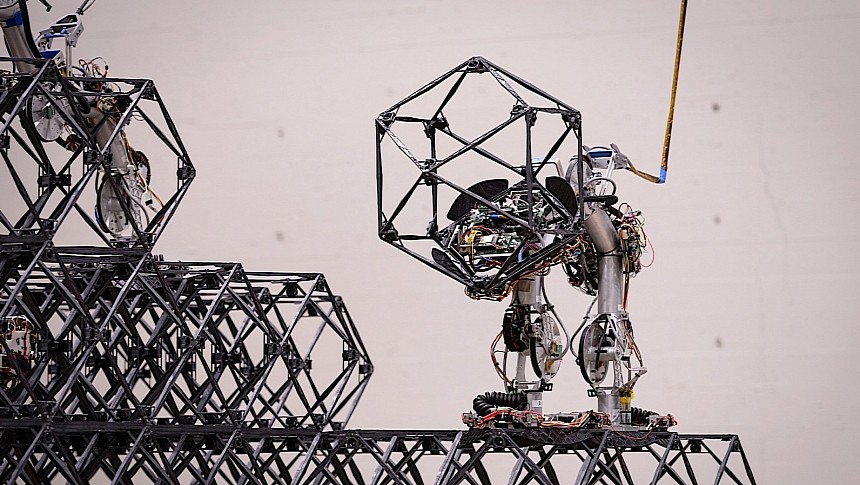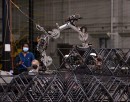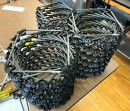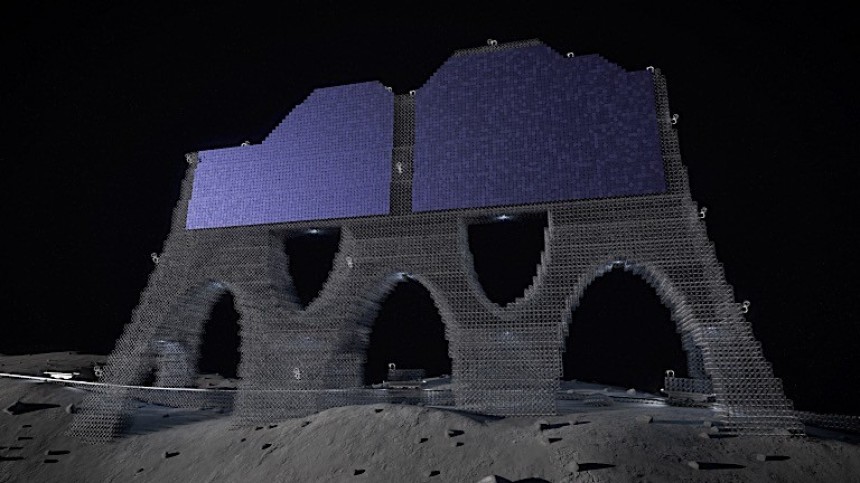With all the sci-fi movies and books at our disposal, and with our imagination fueled even further by the increasingly daring space missions our species is attempting, it's not hard to imagine a not-so-distant future when the space around us is primed and ready to receive our kin. All we need are places to live and the means to get by.
The colonization of the Moon and Mars is likely to be our first major step outward into this Universe. It's close, but not quite here, because there are so many hurdles to overcome a full list of them sitting before our eyes will make our heads spin.
One of these hurdles is our inability to build structures in space. Sure, our species has a real knack for assembling structures in space, but their component parts need to be made here on Earth, loaded onto a rocket, and then propelled to space for assembly.
It's a way of doing things that works for now, but could prove totally inadequate and expensive for long-duration missions to the Moon and Mars. That's why we need ways of using the resources available on-site and the tools to make them all come together in shapes, objects, and structures we can use.
There are several projects at the moment looking into 3D printing as a way of building stuff in space (and by stuff, I mean anything from comms towers to habitats for astronauts), and that seems like a sensible way of going about things. But NASA, or more specifically its Ames Research Center, thinks it has something better up its sleeve: inchworm robots.
Ok, not solely inchworm robots, but a combination of that and structural building blocks plus smart algorithms.
You may not know about it, but NASA is running something called the Automated Reconfigurable Mission Adaptive Digital Assembly Systems. That's ARMADAS for short and it's a project aimed at coming up with the hardware and software needed "to build functional, high-performance large-scale structures."
In a nutshell the idea relies on inchworm-like robots to assemble, repair, and reconfigure structural materials. It's a piece of tech that could just as easily work on the lunar or Martian surface, in any orbit around a celestial body, and completely unsupervised by humans.
Inchworm robots are simple mechanical creatures that move by arching their backs. They are meant to operate in a structure lattice environment, each performing a specific task. Their main goal however is to use building blocks to form any structure imagined by humans.
How is this supposed to work? It's simple, really, and all one has to do is look at a lab demo performed at the Ames Research Center recently. For the run NASA's people used three of these autonomous robots and 3D building blocks NASA calls volumetric pixels (also known as voxels).
The voxels used in the demo were made of lightweight composite materials shaped like a cuboctahedron, a polyhedron with eight triangular faces and six square faces - as per NASA, they look like a wire-frame soccer ball with flat faces.
The three robots used for the procedure had various tasks. Two of them moved on the exterior of the structure being built, transporting one voxel at a time, all the way from a supply station to where they needed to be placed. The third robot's job was to bolt each of the voxels to the rest of the structure.
All three machines operated autonomously during the test, and at the end of it all (we're not told how long it took) NASA's people were left with a structure roughly the size of a shed. And not some flimsy build, but a structure "comparable to today's highest-performance structures," like say the International Space Station's (ISS) trusses.
The team behind the idea, who published their findings in Science Robotics last month, points out several key aspects of using this kind of tech.
The first would be the complexity of the robots, which, by all intents and purposes, is very low. Inchworm machines can easily be made, and because all they have to do is essentially align each small step to a 3D grid, they need not be very complex from a computation and sensing point of view. Because they will work on data they are fed ahead of time, there is no need for machine vision or any other means of external measurement tech.
Then, the size of the structures being built is virtually unlimited. The only thing it depends on is the availability of the building blocks.
Thirdly, there is technically no limit to the kinds of structures that can be constructed – in fact, NASA's people are now working on including things like solar panels, electrical connections, and shielding in the library of voxel types so that the robots know what to do next.
Last but not least, any structure built this way can eventually be repurposed by means of disassembly and then reconfiguration in a new design.
At the time of writing ARMADAS robots are about to get new abilities and features, including inspection tools that could make them indispensable to future space missions. There is no timeframe on when we are to expect a real-life application of the tech, but it will probably be a long time still.
One of these hurdles is our inability to build structures in space. Sure, our species has a real knack for assembling structures in space, but their component parts need to be made here on Earth, loaded onto a rocket, and then propelled to space for assembly.
It's a way of doing things that works for now, but could prove totally inadequate and expensive for long-duration missions to the Moon and Mars. That's why we need ways of using the resources available on-site and the tools to make them all come together in shapes, objects, and structures we can use.
There are several projects at the moment looking into 3D printing as a way of building stuff in space (and by stuff, I mean anything from comms towers to habitats for astronauts), and that seems like a sensible way of going about things. But NASA, or more specifically its Ames Research Center, thinks it has something better up its sleeve: inchworm robots.
Ok, not solely inchworm robots, but a combination of that and structural building blocks plus smart algorithms.
You may not know about it, but NASA is running something called the Automated Reconfigurable Mission Adaptive Digital Assembly Systems. That's ARMADAS for short and it's a project aimed at coming up with the hardware and software needed "to build functional, high-performance large-scale structures."
Inchworm robots are simple mechanical creatures that move by arching their backs. They are meant to operate in a structure lattice environment, each performing a specific task. Their main goal however is to use building blocks to form any structure imagined by humans.
How is this supposed to work? It's simple, really, and all one has to do is look at a lab demo performed at the Ames Research Center recently. For the run NASA's people used three of these autonomous robots and 3D building blocks NASA calls volumetric pixels (also known as voxels).
The voxels used in the demo were made of lightweight composite materials shaped like a cuboctahedron, a polyhedron with eight triangular faces and six square faces - as per NASA, they look like a wire-frame soccer ball with flat faces.
The three robots used for the procedure had various tasks. Two of them moved on the exterior of the structure being built, transporting one voxel at a time, all the way from a supply station to where they needed to be placed. The third robot's job was to bolt each of the voxels to the rest of the structure.
All three machines operated autonomously during the test, and at the end of it all (we're not told how long it took) NASA's people were left with a structure roughly the size of a shed. And not some flimsy build, but a structure "comparable to today's highest-performance structures," like say the International Space Station's (ISS) trusses.
The first would be the complexity of the robots, which, by all intents and purposes, is very low. Inchworm machines can easily be made, and because all they have to do is essentially align each small step to a 3D grid, they need not be very complex from a computation and sensing point of view. Because they will work on data they are fed ahead of time, there is no need for machine vision or any other means of external measurement tech.
Then, the size of the structures being built is virtually unlimited. The only thing it depends on is the availability of the building blocks.
Thirdly, there is technically no limit to the kinds of structures that can be constructed – in fact, NASA's people are now working on including things like solar panels, electrical connections, and shielding in the library of voxel types so that the robots know what to do next.
Last but not least, any structure built this way can eventually be repurposed by means of disassembly and then reconfiguration in a new design.
At the time of writing ARMADAS robots are about to get new abilities and features, including inspection tools that could make them indispensable to future space missions. There is no timeframe on when we are to expect a real-life application of the tech, but it will probably be a long time still.








